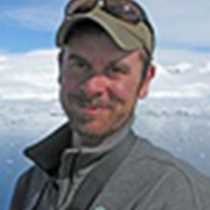Half Moon Island & Deception Island
I think I can speak for most everyone aboard the National Geographic Explorer when I say I awoke this morning to an unexpected sight. Seeing as we were essentially chased out of the Weddell Sea yesterday by rising winds and precariously close icebergs, a morning of deep blue skies and glassy water was not what I was expecting. Our morning at Half Moon Island offered just that, plus a few thousand chinstrap penguins, a few nesting Kelp gulls and Antarctic Terns, a fur seal or two and, the biggest shocker of all, grass! Yep, right here in the South Shetlands, surrounded by 7,000 ft. glaciated peaks, dark, brutal winters and an average summer temperature of 2 degrees Celsius, we found a small green, and seemingly well-nourished, clump of Antarctic hairgrass (Deschampsia antarctica). One of only two flowering plant species found anywhere on the entire continent, this gladiator of grasses, while able to survive sub-zero temperatures, must have loved the balmy 8 degree weather we enjoyed today.
For most of the day, our luck prevailed. Sunny skies guided us from Halfmoon Bay south and west along Livingston Island, and ushered us into our afternoon anchorage within the collapsed, flooded caldera that makes up Deception Island, at the extreme SW corner of the South Shetland chain.
Our initial agenda was to explore the remains of what began as a early twentieth century Norwegian whaling station, turned British military WWII outpost, turned British Antarctic Survey site, turned biological wasteland following a 1970 eruption that decimated most of the structures in the area. Whew! A lot of activity within that 70 year span. Of the remaining structures we were able to tour the massive steel fuel tanks, the defunct living quarters, airplane hangar and processing plant that now sag and droop almost pleasantly into the accompanying, lifelessness of the area.
Now, to be fair, we were joined by exactly two chinstrap penguins and a few south polar Skuas (one with chick in tow) but the biggest surprise was the pale, bipedal creatures we found lurking at the waters edge.
Visible to shocked onlookers through the geologically induced steam seeping from the shoreline’s black sand, what appeared to be scantily-clad human figures entered, then quickly emerged from the mist-enshrouded waters. What could have inspired such a ghastly scene you might ask? How about a mere foot of geologically heated H2O at the edge of a near freezing bay?
How a foot of warmish water would be enough to inspire half a ship’s worth of swimmers might confound most, but to these brave few the experience was one in a million.
I think I can speak for most everyone aboard the National Geographic Explorer when I say I awoke this morning to an unexpected sight. Seeing as we were essentially chased out of the Weddell Sea yesterday by rising winds and precariously close icebergs, a morning of deep blue skies and glassy water was not what I was expecting. Our morning at Half Moon Island offered just that, plus a few thousand chinstrap penguins, a few nesting Kelp gulls and Antarctic Terns, a fur seal or two and, the biggest shocker of all, grass! Yep, right here in the South Shetlands, surrounded by 7,000 ft. glaciated peaks, dark, brutal winters and an average summer temperature of 2 degrees Celsius, we found a small green, and seemingly well-nourished, clump of Antarctic hairgrass (Deschampsia antarctica). One of only two flowering plant species found anywhere on the entire continent, this gladiator of grasses, while able to survive sub-zero temperatures, must have loved the balmy 8 degree weather we enjoyed today.
For most of the day, our luck prevailed. Sunny skies guided us from Halfmoon Bay south and west along Livingston Island, and ushered us into our afternoon anchorage within the collapsed, flooded caldera that makes up Deception Island, at the extreme SW corner of the South Shetland chain.
Our initial agenda was to explore the remains of what began as a early twentieth century Norwegian whaling station, turned British military WWII outpost, turned British Antarctic Survey site, turned biological wasteland following a 1970 eruption that decimated most of the structures in the area. Whew! A lot of activity within that 70 year span. Of the remaining structures we were able to tour the massive steel fuel tanks, the defunct living quarters, airplane hangar and processing plant that now sag and droop almost pleasantly into the accompanying, lifelessness of the area.
Now, to be fair, we were joined by exactly two chinstrap penguins and a few south polar Skuas (one with chick in tow) but the biggest surprise was the pale, bipedal creatures we found lurking at the waters edge.
Visible to shocked onlookers through the geologically induced steam seeping from the shoreline’s black sand, what appeared to be scantily-clad human figures entered, then quickly emerged from the mist-enshrouded waters. What could have inspired such a ghastly scene you might ask? How about a mere foot of geologically heated H2O at the edge of a near freezing bay?
How a foot of warmish water would be enough to inspire half a ship’s worth of swimmers might confound most, but to these brave few the experience was one in a million.




